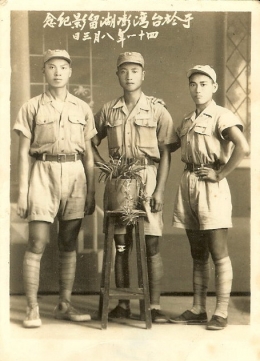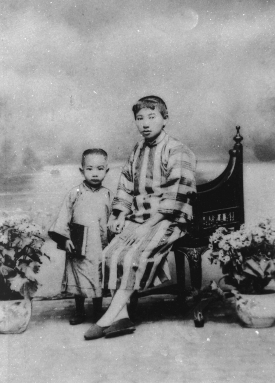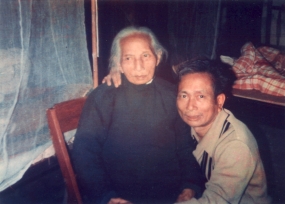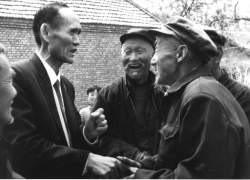TELDAP Collections
| Digital Archive for Memories and Narratives of Taiwan Waishengren |
|
The term“Taiwan waishengren” in general refers to Chinese of mainland origins who settled in Taiwan since 1945 but before 1987, when ban on cross Taiwan Strait visits was lifted after thirty-six years. The term also refers to the younger generations who grow up in Taiwan with mainlander family background. The majority of early generation mainland Chinese arrived in Taiwan between 1949 and 1951 when Chinese Nationalist Party (Kuomintang, or KMT) was on retreat in gruesome civil war with the Communist Chinese. About one to one and half million of people escaped to Taiwan with the KMT government as a result. Many of them had previously been teachers or students, or worked for the government or the military. Waishengren’s journeys of migration and final settlement in Taiwan, and later, their “homebound movement” which challenged the government’s taboo restriction were not only significant in modern history between China and Taiwan, but also a rare incident in refugee history. Because “Waishengren” (meaning from other provinces, or from outside of this province) came from different provinces and regions in China, it would be inappropriate to describe them as one ethnic group. Nonetheless, because of many different factors, “Waishengren” has gradually become a meaningful category used to correlate people with diverse backgrounds. It has also become a social group endowed with action consciousness as contrast to other groups of Taiwanese. Historical factors that have contributed to this phenomenon include: the past concentration of Waishengren in certain occupation groups, such as officials, teachers and military; the political system that privileged a small group of Chinese nationalistic elites to monopolize cultural and political power; and partisan conflicts and mobilization of Taiwanese nativism targeting at mainland Chinese emerged recently after democratization. Even though accommodative social relations have been prevalent across different social backgrounds, political cleavages and resentments are still noticeable occasionally when in conflicts. After 1980s, Taiwan has gradually become an open, pluralistic, and democratic society. But at the same time, because of electoral competitions and nationalistic differences, people of different origins are led to distrust other people of different backgrounds. This has been particularly so for the relation between Waishengren and Hoklo Taiwanese. Stigmatizing and stereotyping on each other with ethnic terms and in resentment have become abrasive and divisive occasionally. Reflecting on the prevalent “over-politicized” view about “ethnic conflicts”, this study adopts a commoner’s viewpoint about their life stories so as to broaden the limited and exclusive nationalistic narration and memories. It intends to reveal the multiple faces and fluidity of subjectivities and identities through the means of digital archiving as we organize and document many aspects of the private past of Waishengren for making them available to public discussions and reviewing. We hope to build the links between inner selves of various individuals with macro-history and structure, allowing the general public to further reflect on suppressions of memories that have resulted from war and authoritarianism. It should then help to enlarge the realm of “inter-subjectivities” as well as a more inclusive civil society outside the realm of political society. Photo of a Youth Army
This photo is of Zhang Shikai (middle) with two of his fellow hometown schoolmates (left and right). Back in 1945, in Guangxi, they joined the Youth Army together. The photo was taken at a studio in 1952 at Magong when they stationed at Penghu Isle. Three young soldiers are found with spirited eye-sights and with puttees neatly tighten up. The photo shows their energetic and vigorous stature. To draw fresh recruits into the military, Chiang Kai-shek called forth the ‘One Hundred Thousand Youths for One Hundred Thousand Military Men’ campaign in 1944, just one year before the end of the war resisting Japanese invasion. The campaign aimed to inspire high patriotism, as its slogan of patriotism said: ‘An Inch Territory for An Inch of Blood’. Students joined the military mostly on voluntary base. The new recruits formed a special unit with the official name of ‘Youth Expeditionary Army’ in January 1945, and later it became known as the “Youth Army”.
Photo of Juancun (Quarters for Military Dependents)
Military dependent’s quarters began to form since 1945. At that time some Kuomintang servicemen were sent to Taiwan to replace the Japanese. Most of their families lived in military units or vacant buildings left behind by Japanese. In 1949, servicemen, some with families, arrived Taiwan in great numbers. At first, they found their own shelters in schools, temples, storehouses, or makeshift buildings. After the conclusion of “Sino-American Mutual Defense Treaty” in 1955, the situation in Taiwan Strait gradually stabilized. The authorities began to relax the stipulation that forbade servicemen marriages. In order to settle hundreds of thousands of servicemen in exile and the increasing population of their families, construction of collective housing was carried out throughout Taiwan expediently. A total of approximately 900 housing projects were constructed. A management system for logistic control by the military was also established. These communities for the settlement of serviceman and their families are called “Juancun”, or literally new villages for military dependents. In early period, when “Juancun” were to be constructed swiftly, the resources were scarce except for some “high-ranking quarters. In the end these houses were built with inexpensive materials for practical purpose. And their structures were done in such a way very much similar like barracks with rows and columns. Most of the living quarters were very narrow and small, and were having little privacy. Not long later, many families began to build “bamboo fence” outward to expand private land. “Bamboo” was the cheapest building materials that could be obtained in Taiwan at the time, and it was an act of self-help among the exile families to establish their home and maintain the private domain in new settlements. Gradually, “bamboo fence” disappeared as they were replaced by brick wall; but “bamboo fence” has become a symbol of the story of many Juancun. Homebound Story of Chen In 1979, Chen was 58, he received letters secretly sent from his hometown, and transferred to hem through the hands of his relatives living in Hong Kong. At then direct mails between Taiwan and mainland China could be sentenced to prison if caught by authority. Chen asked Hong Kong relatives as the middleman for helping him to transcribe his letters and sent back to his old home in mainland. Chen learned that his widowed mother Chao was seriously ill but he could not return because both sides of the government forbade. In 1982, at the age of sixty-one, he set out for home with the help of friends to visit the U.S first. From the U.S. he managed to go back to China with the help of a pastor who was going to China to preach in Beijing. Chen had finally returned home, and saw his mother after being separated for almost thirty three years. Chen returned to the US. after this visit. Despite of his age, he worked in restaurants to save more money to send back home. He had once passed out because of excessive fatigue. Even life was extremely difficult, he was committed “to savor up the pain as well as the bitterness of the world” so that he can render his is filial service to his aging and ill mother. Chen now settled in Hualian, Taiwan. He purchased a home in mainland Fuzhou, and he often travels between Taiwan and China.
Photo 5 was taken in 1982. After passing through the third country--United States, and successfully returned to his hometown Gaishan Town, Fuzhou City. Chen and his mother were reunited finally after thirty-three years of separation. Looking at these two photos (photo 4 and 5), the time span is fifty five years. The sequence of photos illustrates the intense homebound feeling of some first generation Waishengren. When KMT Government retreated to Taiwan, roughly began from 1950 and onward, it started to arrest massively against suspects of “bandit spy” in name of maintaining the stability of Taiwan's society. It is the period of time known as “White Terror” In modern time Taiwan. The Waishengren Homebound Movement His secret and successful return prompted Jiang to consider the first generation of surviving Waishengren like him caught in the same situation. They miss their families in homeland China, but dared not to speak out nor dared to write letters. In 1987, Jiang and others organized “Waishengren Veterans Association for Returning Home" and planned with political activists to help veteran friends to return their hometown in China and visit their relatives. The movement may have facilitated the authoritarian president Chiang Ching-Kuo to agree to lift the ban in December 1988 to allow the people to return to mainland to visit relatives. Moreover, it has become a part of the liberalization policy of Taiwan’s authoritarian regime, and initiated itself as the first wave of exchanges between people across Taiwan Strait.
Photo 6 was taken on June 28, 1987. It was a scene when “Waishengren Veteran Association for Returning Home” held a public rally at the Chinhua Girls’ High School (Chinhua Junior high school, Taipei now). Jiang (left) wore a T-shirt with two Chinese characters saying “missing home.” He and folk song singer Yang Zuchun (right) sang in chorus of a song named “The one I miss.” In the lyrics, “Looks as far as the eyes can see to the cloud and mountain, but cannot see mother's benevolent countenance.” The song and the scene illustrate the sufferings many aging Waishengren in Taiwan at then must endure. In the period of 38 years from 1949 to 1987, the governments on both sides of Taiwan Strait had forbidden any exchanges of the people. Then, a group of retired veterans of mainland China origin in Taiwan, with assistance of political activists, began to establish “Waishengren’s Association for Returning Home”. They demanded the Taiwanese government to lift the ban on martial law and allow people of all political camps “who cannot return to hometown” to return to their hometown. Except mainland veteran, the association also includes those exile Taiwanese dissidents, and Taiwan aborigines who have lost their land in history. Scene of Returning Home
”Shandong Exile School” refers to junior high schools which originated from Shandong province, and then moved from places to places escaping from falling into the Communists hands during the Civil War in China. In 1948, teachers and students made it to the very south of mainland China, near Guangzhou area. Hungry and desperate, they asked for the help from a member to the National Assembly who were also originated from Shandong to negotiate with the military. Somewhat reluctantly, the military agreed to ship about 8,000 teachers and students to Penghu Isles. However, on June 25, 1949, the military broke its promise made earlier to students: “go to Taiwan and continue schooling”. The 39th division of Penghu Headquarters began to draft students with force as it was short of recruits. Zhang Minzhi, as the principal of Yantai Union High School, together with Zhou Jian resisted the military’s order. In retaliation, Penghu military falsified a ghost “Communist Democracy of Youth League” to frame school leaders. Both were executed after military sentence. Reportedly some disobedient students were thrown into the sea to drown by soldiers without any trial. It is documented as the first case of Waishengren suppressed in White Terror. It is known today as “The case of Shandong Exile Student in Penghu”.
Text and images are provided by the Institute of Sociology, Academia Sinica (Digital Archive for Memories and Narratives of Taiwan Waishengren)
|


















